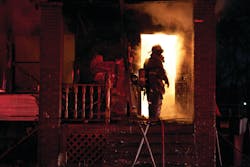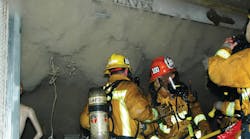Fireground Operations: How to Nail Your First-Due Strategic Responsibility Part 2
Part one of this series (January 2012) followed Engine 54’s response to a fire in a one-story building, focusing on the company officer’s on-scene arrival report and the firefighters’ offensive entry and whether they met National Fire Protection Association (NFPA) standards. This installment looks at what the standards recommend as a first-due fire officer’s strategic responsibility.
NFPA 1021, Fire Officer I
4.6.1 DEVELOP AN INITIAL ACTION PLAN, GIVEN SIZE-UP INFORMATION for an incident and assigned emergency response resources, so that resources are deployed to control the emergency.
4.6.2 IMPLEMENT AN ACTION PLAN AT AN EMERGENCY OPERATION, given assigned resources, type of incident, and a preliminary plan, so that resources are deployed to mitigate the situation. (THIS REQUIREMENT TAKES INTO CONSIDERATION THE OFFICER’S ABILITY TO GIVE ORDERS, DIRECT PERSONNEL, EVALUATE INFORMATION, AND ALLOCATE RESOURCES to respond to the wide variety of emergency situations the fire service encounter.
This national consensus standard recommends that the first on-scene officer complete a size-up, develop an “initial” Incident Action Plan (IAP) and (this makes it interesting) implement that plan. How can a fire officer accomplish this strategic evolution outside the building while performing a tactical evolution inside the building? The intent of this standard is for the first-on-scene officer to function as a fire officer rather than a firefighter.
Also notice that NFPA 1021, Fire Officer I, takes into consideration the officer’s “ability” to give orders, direct personnel, evaluate information and allocate resources. I guarantee that the intent of the NFPA 1021 committee was NOT for first on-scene fire officer to jump off the rig and dash into the building with a hoseline.
For the sake of argument, let’s say that the Engine 54 officer did complete a focused size-up and did develop an IAP based on a risk-versus-value appraisal. Where should the Engine 54 officer be positioned in order to “implement” the preliminary action plan? Advancing a hoseline doing fire attack? Crawling through smoke doing search and rescue? On the roof with a power saw? Negative; those are tactical positions and task-level firefighter duties. The officer implementing the action plan (in this case, “Main Street Command”) must be outside the immediately dangerous to life or health (IDLH) area and command from a strategic position called a command post.
There’s another NFPA standard that dovetails nicely with NFPA 1021:
NFPA 1561, Standard for Emergency Services Incident Management System
4.5.3 The system shall include a SPECIFIC MEANS TO IDENTIFY AND KEEP TRACK OF RESPONDERS ENTERING AND LEAVING HAZARDOUS AREAS, especially where special protective equipment is required.
5.3.12 THE INCIDENT COMMANDER SHALL INITIATE AN ACCOUNTABILITY AND INVENTORY WORKSHEET at the beginning of operations and shall maintain that system throughout operations.
If I’m not mistaken, these NFPA 1561 citations describe what a fire officer called “Main Street Command” should be doing. What Engine 54 did is provide a bunch of words that sound important on the radio, most of which don’t mean anything. What Engine 54’s arrival report fosters is reckless, unsafe and in many states illegal. It ignores often-repeated National Institute for Occupational Safety and Health (NIOSH) fatality investigation recommendations and ignores consensus standards such as NFPA 1021, NFPA 1561 and NFPA 1500.
Fast-attack flaws
What the arrival report by Engine 54 describes is a dubious operational mode called “fast attack,” which describes an offensive mode with the following corners rounded:
1. NO size-up.
2. NO Initial Action Plan.
3. NO water supply.
4. NO coordinated ventilation.
5. NO two-out standby team.
6. NO incident commander at a command post.
As each corner is rounded, risk increases and the operation departs from best practices established by NFPA standards and the Occupational Safety and Health Administration (OSHA) mandate, not to mention that fire department liability escalates. If you are a mature, common-sense, strategic thinker, you probably share our judgment: the term “fast attack” needs to be whacked and buried deep so that nobody will find it. “Fast attack” encourages reckless, unsafe and illegal behavior. (We are not advocating that Engine 54 loiter on-scene until the cavalry arrives. There is plenty to do, both strategically and tactically, before throwing the offensive switch.)
Timed hose evolutions
It is no mystery why the company officer on Engine 54 jumped off the rig and defaulted to fast-attack mode: it is embedded in the culture. For decades, many fire departments have reinforced (albeit unintentionally) that company officers function as task-level firefighters. Consider this example:
1. To test the tactical competency of an engine company, the training division schedules a timed hose evolution.
2. The tested engine company has three personnel: officer, driver and firefighter.
3. The selected evolution is forward from a hydrant; the evolution evaluator has a clipboard, stopwatch and task-level checklist. The clock starts when the engine stops at the hydrant.
4. After stopping at the hydrant, the firefighter loops the supply hose to the hydrant and signals the driver to drive forward. The firefighter remains to dress and operate the hydrant.
5. After dropping a couple hundred feet of supply hose, the engine stops. The driver chocks, pumps and establishes the hydrant supply to the engine.
6. What does the officer do? (Remember the stopwatch is ticking.) The officer shoulders and extends a pre-connected hoseline.
7. After charging the hydrant supply line, the firefighter joins the company officer, who is at the nozzle.
8. The clock stops when the officer (or firefighter) opens the bale and shows water.
Are you aware that an NFPA standard describes and diagrams this tactical evolution? It’s NFPA 1410, Standard on Training for Initial Emergency Scene Operations. Nowhere in the NFPA 1410 timed-evolution descriptions does it recommend that the officer do strategic-level fire officer-stuff. In fact, as described in the example above, according to section 6.1.1 (and diagrammed in A6.1.1), there doesn’t need to be a company officer on the engine to successfully “pass” the evolution time standard.
I can’t think of better justification for a four-person engine company than to liberate the first on-scene company officer to do officer-stuff. As described, this fundamental hose evolution reinforces the notion of “fast attack” by sacrificing strategic focus for tactical speed.
Call to action
If you somehow missed the purpose of this article, here it is: What the first-due fire officer does during the first on-scene minutes will make or break the operation. To ensure that the first on-scene minutes provide strategic significance, the officer responsibility has been identified by NFPA 1021, Fire Officer I, 4.6.1 and 4.6.2. To reinforce NFPA 1021, look to NFPA 1561, 4.5.3 and 5.3.12. If that’s not enough, there’s OSHA 29 CFR 1910.134(g)(4), which mandates a minimum of four personnel be assembled on scene before entering a self-contained breathing apparatus (SCBA)-required environment. If that is still not enough, the OSHA mandate is reinforced by NFPA 1500, 8.5.7.
I know that a few readers are thinking they don’t care what the NFPA standards say. Really? If you wouldn’t dare purchase an apparatus ground ladder that doesn’t comply with NFPA 1931, why would you tolerate a company officer who doesn’t comply with NFPA 1021? If your first-due company officers are not going to do officer work, there’s no need for first-due apparatus to respond with an officer onboard!
Your call to action is to understand The Problem. Do so by familiarizing yourself with the cited NFPA standards, revisit the OSHA mandate (or NFPA 1500, 8.5.7, which aligns with the OSHA mandate), cross-reference to determine whether your procedures align and factor how the culture of your department might interfere (or discourage) strategic expectations. Is there a downside to ensuring that your company officers comply with NFPA 1021 and NFPA 1561?
Next: A structured and systematic process – “The Solution – that enables fire officers to nail their first-due responsibility every time.
MARK EMERY, EFO, a Firehouse® contributing editor, is a fire commissioner with Woodinville Fire and Rescue in King County, WA, from which he retired in 2010 as an operations battalion chief. He also is president of Fire Command LLC. Emery is a graduate of the National Fire Academy’s Executive Fire Officer (EFO) Program and received a bachelor of arts degree from California State University at Long Beach. STEWART ROSE is a fire service instructor who retired from the Seattle, WA, Fire Department as deputy chief and director of training and safety. He also was a shift commander, battalion commander and first-line supervisor of engines, trucks and fireboats. He has served on numerous fire service committees nationally.







